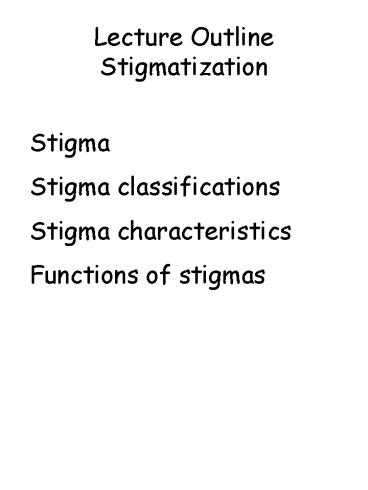Lecture Outline Stigmatization PowerPoint PPT Presentation
1 / 38
Title: Lecture Outline Stigmatization
1
Lecture OutlineStigmatization
- Stigma
- Stigma classifications
- Stigma characteristics
- Functions of stigmas
2
Stigma
- Consensual beliefs about undesirable attributes
or characteristics
3
Stigma Classifications (Goffman, 1963)
- 1. Tribal identities
- 2. Abominations of the body
- 3. Blemishes of individual character
4
Stigma Classifications (Goffman, 1963)
- Tribal identities
- Social groups into which individuals are born
- religious groups
- ethnic groups
- racial groups
- national groups
5
Stigma Classifications (Goffman, 1963)
- Abominations of the body
- Physical ailments
- deformities
- illnesses
- paralysis
6
Stigma Classifications (Goffman, 1963)
- Blemishes of individual character
- Moral transgressions, weakness of will
- drug addiction
- prostitution
- homosexuality
- mental illnesses
7
Stigma
- According to Goffman (1963)
- Stigmatized groups
- regarded by many as flawed
8
- People report that they do not emulate, or try to
be like, the stigmatized - Stereotypes about stigmatized groups are negative
- Individuals with stigmas are victims of
prejudice, discrimination, hate crimes
9
Homophobia StudyAdams, Wright, Lohr (1996)
Homophobic Men
Non-Homophobic Men
Viewed three sexually explicit video tapes
Heterosexuals
Lesbians
Gay men
Both groups sexually aroused
Both groups sexually aroused
Which group was aroused? You fill it in.
10
Stigma Characteristics
- Dimensions along
- which stigmas can differ
11
Concealibility
Extent to which a stigma can be hidden from
others
12
Stability
Extent to which a stigma can change over time
13
Disruptiveness
Extent to which a stigma disrupts social
interactions
14
Aesthetic Qualities
Extent to which a stigma is physically
unappealing to others
15
Responsibility
Extent to which a stigmatized person is seen as
personally responsible for their stigma
16
Danger (Peril)
Extent to which a stigmatized person is seen as
dangerous
17
What we do know...
- Stigma characteristics are
- not all-or-none
18
What we do know...
- Stigma characteristics are
- not mutually exclusive
19
What we do know...
- People can hold different beliefs about a
stigmas characteristics
20
Functions of Stigmas
- Self-enhancement function
- Social identity function
- System justification function
- Terror management function
21
Self-Enhancement Function
- Stigmatizing out-groups make people feel better
about themselves - Based on Downward Comparison Theory
22
Social Identity Theory
- Assumptions
- People categorize others into in/out groups
- Categorization creates a social identity
- People want to be in groups held in high esteem
- People sustain positive identity by derogating
out-groups
23
Self-Enhancement vs. Social Identity Theory
- Self-Enhancement
Derogate the stigmatized
Feel good about oneself
Social Identity Theory
Derogate the stigmatized
Feel good about oneself
Feel good about ones group
24
Self-Enhancement Social Identity Functions
Limitations Consensual nature
Self-devaluation of stigmas
Self-Enhancement
Self-Enhancement
Social Identity
25
Self-Devaluation StudyClark Clark (1939)
- 253 African American children
- Presented with 4 dolls
- 2 brown with black hair
- 2 white with yellow hair
- Children asked questions
26
Self-Devaluation StudyClark Clark (1939)
- Identify actual color of doll
- Example questions
- Give me the brown doll
- Give me the white doll
27
Self-Devaluation StudyClark Clark (1939)
- Result
- Children correctly identified the dolls color
- 93 gave the brown doll when asked
- 94 gave the white doll when asked
28
Self-Devaluation StudyClark Clark (1939)
- Identify racial identity of doll
- Example questions
- Give me the doll that looks like an African
American child - Give me the doll that looks like a White child
29
Self-Devaluation StudyClark Clark (1939)
- Results
- Children able to identify the dolls racial
identity - 93 gave the brown doll when asked for the one
that looked like an African American child - 93 gave white doll when asked for the one that
looked like a White child
30
Self-Devaluation StudyClark Clark (1939)
- Identify childs racial identity
- Example questions
- Give me the doll that
- looks like you
31
Self-Devaluation StudyClark Clark (1939)
- Results
- Children not as good at identifying their own
racial identity - 66 gave the brown doll when asked which looked
like them - 33 gave the white doll when asked which looked
like them
32
Self-Devaluation StudyClark Clark (1939)
- Identify racial preference
- Example questions
- Give me the doll you like best
- Give me the doll that looks bad
- Give me the doll that is a nicer color
33
Self-Devaluation StudyClark Clark (1939)
- Results
- Children devalued own racial identity
- 66 liked the white doll best
- 59 said the brown doll looked bad
- only 38 said the brown doll was a nice color
34
System Justification TheoryAssumptions
Group inequalities in every society Advantaged
groups derogate stigmatized groups to justify why
they have more Justifications show how the
system is fair
35
System Justification TheoryThrough system
justification people
1. Come to believe that they deserve their
privilege 2. The system under which their
culture operates is fair 3. Perception of
fairness reduces intergroup conflict
36
System Justification Theory
Limitations Cannot explain social revolutions
that initially heighten intergroup conflict
37
Terror Management Function Assumptions
People are aware of their own mortality This
awareness creates anxiety People protect self
from this anxiety by subscribing to a cultural
view that provides order meaning to an
otherwise random world
38
Terror Management
Stigmatization serves to reject those who are
different and who violate and challenge cultural
views

